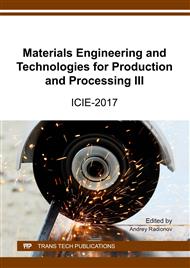[1]
P.A. Alabuzhev, L. Gritchin, L. Kim, G. Migirenko, V. Chon and P. Stepanov, Vibration Protecting and Measuring Systems with Quasi-Zero Stiffness, Hemisphere Publishing, New York, (1989).
Google Scholar
[2]
A.R. Valeev and Sh.A. Kharisov, Application of Vibration Isolators with a Low Stiffness for the Strongly Vibrating Equipment, Procedia Engineering, 150 (2016) 641-646.
DOI: 10.1016/j.proeng.2016.07.060
Google Scholar
[3]
A.R. Valeev, A.N. Zotov, Sh.A. Kharisov, Designing of compact low frequency vibration isolator with quasi-zero stiffness. Journal of low frequency noise, vibration and active control, 34 (4) (2015) 459-474.
DOI: 10.1260/0263-0923.34.4.459
Google Scholar
[4]
A. Carrella and M.I. Friswell, A passive vibration isolator incorporating a composite bistable plate. Proceedings of 6th European Nonlinear Dynamics Conference, Saint Petersburg, (2008).
Google Scholar
[5]
A. Carrella, M. Brennan, and T.P. Waters, Static analysis for a passive vibration isolator with quasi-zero stiffness characteristic. Journal of Sound and Vibration, 301(3-5) (2007) 678-689.
DOI: 10.1016/j.jsv.2006.10.011
Google Scholar
[6]
A. Carrella, M. Brennan, and T.P. Waters. Optimization of a quasi-zero-stiffness isolator. Journal of Mechanical Science and Technology, 21 (2007) 946-949.
DOI: 10.1007/bf03027074
Google Scholar
[7]
X. Sun, J. Xu, X. Jing and L. Cheng, Beneficial performance of a quasi-zero-stiffness vibration isolator with time-delayed active control. International Journal of Mechanical Sciences, 82 (2014) 32-40.
DOI: 10.1016/j.ijmecsci.2014.03.002
Google Scholar
[8]
T.D. Le and K.K. Ahn, Fuzzy sliding mode controller of a pneumatic active isolating system using negative stiffness structure. Journal of Mechanical Science and Technology, 26(12) (2012) 3873-3884.
DOI: 10.1007/s12206-012-0890-9
Google Scholar
[9]
X. Sun, J. Xu, X. Jing and L. Cheng. Beneficial performance of a quasi-zero-stiffness vibration isolator with time-delayed active control, International Journal of Mechanical Sciences, 82 (2014) 32-40.
DOI: 10.1016/j.ijmecsci.2014.03.002
Google Scholar
[10]
I. Maciejewski, L. Meyer and T. Krzyzynski. Modelling and multi-criteria optimization of passive seat suspension vibroisolating properties. Journal of Sound and Vibration, 324 (2009) 520-538.
DOI: 10.1016/j.jsv.2009.02.021
Google Scholar
[11]
T.D. Le and K.K. Ahn, A vibration isolation system in low frequency excitation region using negative stiffness structure for vehicle seat. Journal of Sound and Vibration, 330 (2011) 6311-6335.
DOI: 10.1016/j.jsv.2011.07.039
Google Scholar
[12]
A. Carrella, Passive vibration isolators with high-static-low-dynamic-stiffness, Ph.D. Thesis, University of Southampton, UK, (2008).
Google Scholar
[13]
A.R. Valeev, A.N. Zotov and A. Yu. Tikhonov, Vibration isolating shafts suspension with quasi-zero stiffness, Problems of gathering, treatment and transportation of oil and oil products, 3 (2010) 68-77.
Google Scholar
[14]
D.M. Correa, C.C. Seepersad and M.R. Haberman, Mechanical design of negative stiffness honeycomb materials, Integrating Materials and Manufacturing Innovation, (2015).
DOI: 10.1186/s40192-015-0038-8
Google Scholar
[15]
D.M. Correa, T.D. Klatt, S.A. Cortes, M.R. Haberman, D. Kovar, and C.C. Seepersad, Negative Stiffness Honeycombs for Recoverable Shock Isolation, Rapid Prototyping Journal, (2015).
DOI: 10.1108/rpj-12-2014-0182
Google Scholar
[16]
Z. Wang, Q. Zhang, K. Zhang and G. Hu, Tunable digital metamaterial for broadband vibration isolation at low frequency, Advanced materials, (2016).
DOI: 10.1002/adma.201604009
Google Scholar


